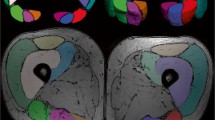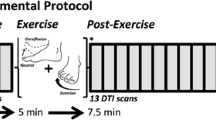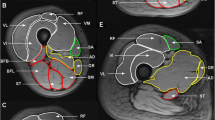Abstract
Object
The object was to assess whether cross-sectional area (CSA) and water diffusion properties of leg muscles in young and older women change with increased time spent in supine rest.
Materials and methods
Healthy young (n = 9, aged 20–30 years) and older (n = 9, aged 65–75 years) women underwent MRI scanning of the right leg at baseline, 30 and 60 min of supine rest. Muscle CSA was derived from proton density images. Water diffusion properties [apparent diffusion coefficient (ADC) and fractional anisotropy (FA)] of the tibialis anterior and posterior, soleus, and medial and lateral heads of the gastrocnemius were derived from diffusion tensor imaging (DTI). Repeated measures ANOVAs and Bonferroni post hoc tests determined the effects of time and group on each muscle outcome.
Results
In both groups, muscle CSA and FA did not significantly change over time, whereas ADC significantly decreased. A greater decline at 30 min for young women was only observed for ADC in the medial gastrocnemius.
Conclusion
Regardless of age, ADC values decreased with fluid shift associated with time spent supine, whereas CSA and FA were not affected. For leg muscle assessment in young and older women, DTI scanning protocols should consider the amount of time spent in a recumbent position.





Similar content being viewed by others
References
Zaraiskaya T, Kumbhare D, Noseworthy MD (2006) Diffusion tensor imaging in evaluation of human skeletal muscle injury. J Magn Reson Imaging 24:402–408
Berg HE, Tedner B, Tesch PA (1993) Changes in lower limb muscle cross-sectional area and tissue fluid volume after transition from standing to supine. Acta Physiol Scand 148:379–385
Mathur S, Lott DJ, Senesac C, Germain SA, Vohra RS, Sweeney HL, Walter GA, Vandenborne K (2010) Age-related differences in lower-limb muscle cross-sectional area and torque production in boys with Duchenne muscular dystrophy. Arch Phys Med Rehabil 91:1051–1058
Schwenzer NF, Martirosian P, Machann J, Schraml C, Steidle G, Claussen CD, Schick F (2009) Aging effects on human calf muscle properties assessed by MRI at 3 Tesla. J Magn Reson Imaging 29:1346–1354
Buford TW, Lott DJ, Marzetti E, Wohlgemuth SE, Vandenborne K, Pahor M, Leeuwenburgh C, Manini TM (2012) Age-related differences in lower extremity tissue compartments and associations with physical function in older adults. Exp Gerontol 47:38–44
Tuttle LJ, Sinacore DR, Mueller MJ (2012) Intermuscular adipose tissue is muscle specific and associated with poor functional performance. J Aging Res 2012:172957
Basu R, Basu A, Nair KS (2002) Muscle changes in aging. J Nutr Health Aging 6:336–341
Kent-Braun JA, Ng AV, Young K (2000) Skeletal muscle contractile and noncontractile components in young and older women and men. J Appl Physiol 88:662–668
Murtagh KN, Hubert HB (2004) Gender differences in physical disability among an elderly cohort. Am J Public Health 94:1406–1411
Galban CJ, Maderwald S, Uffmann K, de Greiff A, Ladd ME (2004) Diffusive sensitivity to muscle architecture: a magnetic resonance diffusion tensor imaging study of the human calf. Eur J Appl Physiol 93:253–262
Hasson CJ, Caldwell GE (2012) Effects of age on mechanical properties of dorsiflexor and plantarflexor muscles. Ann Biomed Eng 40:1088–1101
Holmback AM, Porter MM, Downham D, Andersen JL, Lexell J (2003) Structure and function of the ankle dorsiflexor muscles in young and moderately active men and women. J Appl Physiol 95:2416–2424
Galban CJ, Maderwald S, Uffmann K, Ladd ME (2005) A diffusion tensor imaging analysis of gender differences in water diffusivity within human skeletal muscle. NMR Biomed 18:489–498
Galban CJ, Maderwald S, Stock F, Ladd ME (2007) Age-related changes in skeletal muscle as detected by diffusion tensor magnetic resonance imaging. J Gerontol A Biol Sci Med Sci 62:453–458
Sinha U, Csapo R, Malis V, Xue Y, Sinha S (2014) Age-related differences in diffusion tensor indices and fiber architecture in the medial and lateral gastrocnemius. J Magn Reson Imaging. doi:10.1002/jmri.24641
Conley MS, Foley JM, Ploutz-Snyder LL, Meyer RA, Dudley GA (1996) Effect of acute head-down tilt on skeletal muscle cross-sectional area and proton transverse relaxation time. J Appl Physiol 81:1572–1577
Maw GJ, Mackenzie IL, Taylor NA (1995) Redistribution of body fluids during postural manipulations. Acta Physiol Scand 155:157–163
Elzibak AH, Noseworthy MD (2013) Assessment of diffusion tensor imaging indices in calf muscles following postural change from standing to supine position. Magn Reson Mater Phy. doi:10.1007/s10334-013-0424-1
Lieber R (2002) Skeletal muscle structure, function, and plasticity: The physiological basis of rehabilitation. Lippincott Williams and Wilkins, Philadelphia
Andersen JL (2003) Muscle fibre type adaptation in the elderly human muscle. Scand J Med Sci Sports 13:40–47
Miwa C, Sugiyama Y, Mano T, Matsukawa T, Iwase S, Watanabe T, Kobayashi F (2000) Effects of aging on cardiovascular responses to gravity-related fluid shift in humans. J Gerontol A Biol Sci Med Sci 55:M329–M335
International Society for the Advancement of Kinanthropometry (2001) International standards for anthropometric assessment. International Society for the Advancement of Kinanthropometry, Australia
Rittweger J, Beller G, Ehrig J, Jung C, Koch U, Ramolla J, Schmidt F, Newitt D, Majumdar S, Schiessl H, Felsenberg D (2000) Bone–muscle strength indices for the human lower leg. Bone 27:319–326
Jenkinson M, Beckmann CF, Behrens TE, Woolrich MW, Smith SM (2012) FSL. Neuroimage 62:782–790
Wang R, Benner T, Sorensen A, Wedeen V (2007) Diffusion toolkit: a software package for diffusion imaging data processing and tractography. In: Proceedings of the 16th scientific meeting of the international society for magnetic resonance medicine, Berlin, p 3720
Jenkinson M, Bannister P, Brady M, Smith S (2002) Improved optimization for the robust and accurate linear registration and motion correction of brain images. Neuroimage 17:825–841
Cox RW (1996) AFNI: software for analysis and visualization of functional magnetic resonance neuroimages. Comput Biomed Res 29:162–173
Le Bihan D, Mangin JF, Poupon C, Clark CA, Pappata S, Molko N, Chabriat H (2001) Diffusion tensor imaging: concepts and applications. J Magn Reson Imaging 13:534–546
Dietrich O, Raya JG, Reeder SB, Reiser MF, Schoenberg SO (2007) Measurement of signal-to-noise ratios in MR images: influence of multichannel coils, parallel imaging, and reconstruction filters. J Magn Reson Imaging 26:375–385
Elzibak AH, Noseworthy MD (2013) Investigation of diffusion tensor imaging indices, mean BOLD signal and calf muscle cross sectional area following bed rest. In: Proceedings of the 21st scientific meeting of the international society for magnetic resonance medicine, Salt Lake City, p 5342
Monahan KD, Ray CA (2004) Gender affects calf venous compliance at rest and during baroreceptor unloading in humans. Am J Physiol Heart Circ Physiol 286:H895–H901
Convertino VA (1998) Gender differences in autonomic functions associated with blood pressure regulation. Am J Physiol 275:R1909–R1920
White DD, Montgomery LD (1996) Pelvic blood pooling of men and women during lower body negative pressure. Aviat Space Environ Med 67:555–559
Brown MD, Jeal S, Bryant J, Gamble J (2001) Modifications of microvascular filtration capacity in human limbs by training and electrical stimulation. Acta Physiol Scand 173:359–368
Charles M, Charifi N, Verney J, Pichot V, Feasson L, Costes F, Denis C (2006) Effect of endurance training on muscle microvascular filtration capacity and vascular bed morphometry in the elderly. Acta Physiol (Oxf) 187:399–406
Sinha S, Sinha U, Edgerton VR (2006) In vivo diffusion tensor imaging of the human calf muscle. J Magn Reson Imaging 24:182–190
Williams SE, Heemskerk AM, Welch EB, Li K, Damon BM, Park JH (2013) Quantitative effects of inclusion of fat on muscle diffusion tensor MRI measurements. J Magn Reson Imaging 38:1292–1297
Andre JB, Bammer R (2010) Advanced diffusion-weighted magnetic resonance imaging techniques of the human spinal cord. Top Magn Reson Imaging 21:367–378
Damon BM (2008) Effects of image noise in muscle diffusion tensor (DT)-MRI assessed using numerical simulations. Magn Reson Med 60:934–944
Karampinos DC, King KF, Sutton BP, Georgiadis JG (2007) In vivo study of cross-sectional skeletal muscle fiber asymmetry with diffusion-weighted MRI. Conf Proc IEEE Eng Med Biol Soc 2007:327–330
Karampinos DC, King KF, Sutton BP, Georgiadis JG (2009) Myofiber ellipticity as an explanation for transverse asymmetry of skeletal muscle diffusion MRI in vivo signal. Ann Biomed Eng 37:2532–2546
Froeling M, Nederveen AJ, Nicolay K, Strijkers GJ (2013) DTI of human skeletal muscle: the effects of diffusion encoding parameters, signal-to-noise ratio and T2 on tensor indices and fiber tracts. NMR Biomed 26:1339–1352
Acknowledgments
The study was funded in part by a grant from The Arthritis Society. The authors thank Norm Konyer and the MRI technologists (Janet Burr, Cheryl Contant and Julie Lecomte) for their assistance throughout data collection. AL is funded in part by the Ontario Women’s Health Scholar Award and the Joint Motion Program, a Canadian Institutes of Health Research Training Program in Musculoskeletal Health Research and Leadership.
Conflict of interest
I certify that there is no actual or potential conflict of interest in relation to this article.
Ethical standard
This study was approved by our institutional research ethics board. Informed consent was provided by all participants.
Author information
Authors and Affiliations
Corresponding author
Rights and permissions
About this article
Cite this article
Lorbergs, A.L., Noseworthy, M.D. & MacIntyre, N.J. Age-related differences in the response of leg muscle cross-sectional area and water diffusivity measures to a period of supine rest. Magn Reson Mater Phy 28, 279–290 (2015). https://doi.org/10.1007/s10334-014-0464-1
Received:
Revised:
Accepted:
Published:
Issue Date:
DOI: https://doi.org/10.1007/s10334-014-0464-1




